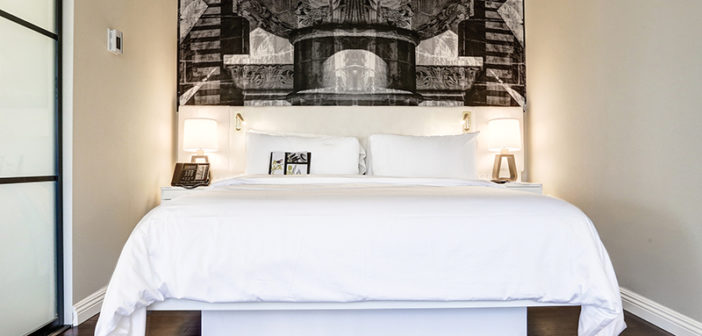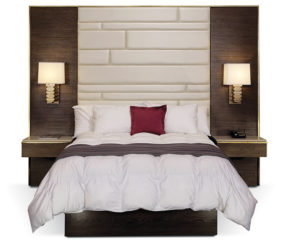NATIONAL REPORT—Headboards in the guestroom are becoming focal points, directing the eyes toward the bed and capturing the essence of the overall design. Interior designers no longer look at these products as obstacles; headboards have now become the starting point for many designs. Designers are using these vertical boards to build out the complexity of the rooms by shaping the theme, thereby telling the story.
“Headboards are becoming more integrated into the architectural and interior design of the guestroom,” said Jonathan Fu, head of marketing and design at CF Kent, a contract furniture manufacturer for the hospitality industry. The family-owned business creates products for hotel groups and brands worldwide, including IHG, Wyndham, Hilton and Marriott. Operating for more than 25 years, it also supplies customized furniture solutions to non-franchised and boutique-style hotels.
“I think when a guest first enters the room, the first thing on his or her mind is, ‘Where am I going to sleep?’” he said. “So naturally, the guest will scrutinize the bed, which should be complemented by the headboard and help set the mood for the guest’s stay.”
Deaderia Morris, director of interior design for Kimball Hospitality, explained to Hotel Business how the headboard is the centerpiece of the guestroom; it’s of the utmost importance to conceptualize an inviting environment for guests seeking comfort. “The hotel is first selling a great place to sleep; the bed is the main element of the room, so its headboard design has an enormous allure to the guest,” she said.
Headboards serve a purpose in various capacities. While they do assist designers with the overall feel of the guestroom, they also incorporate additional functionality by featuring technological components to enhance the experience of a guest’s stay. Observing guest habits assists designers with customizing the headboard.
“Headboards often include integrated lighting and power outlets as designers realize guests spend most of their time in the bed using electronic devices,” Fu noted.
Creating custom headboards for guestrooms integrates the designer’s vision with the guest’s needs, reinforcing hospitable notions by simply thinking ahead and understanding the expectations of the modern-day business and leisure traveler.
“A headboard must serve multiple purposes and the designer must bundle these into an attractive and harmonious design,” Morris told Hotel Business in an interview. “A headboard design needs to consider lighting for reading, ambient lighting for relaxation, as well as incorporating outlets and USB ports for charging.”
Due to size, the headboard “dominates the room and may contain ‘mood’ lighting that is recessed in a channel on the top of the headboard,” said Nick Hart, owner at 410 Hogan, a custom hospitality furniture business. Additional lighting can be found in the headboard’s side panels. “Everything is at a finger’s touch from the bed,” he added.
“The headboard is one of the few furniture items in a room that almost has no limit in terms of how it can be designed,” Fu said. “As compared to a desk or dresser, where the form follows function, the headboard can be designed to be both decorative and functional. That being said, a designer has to consider how the aesthetic will affect the room layout, as well as be aware of what features to integrate into the design.”
The visual aspect of the headboard: colors and tones, materials and fabrics, and shapes and sizes—all of which are essential to providing a comfortable guest stay. It can set the mood and create a welcoming atmosphere in every guestroom.
“Some designers are now using a full-wall design of the headboard, mostly of mixed materials to enhance the architectural design of the room,” Morris said.
Among the most popular mixed materials are gray-tone veneers, gold-tone metals, textured vinyls and accent mirrors, she noted. Many designers are also incorporating photographs and art into the headboard design. “Headboards are a beautiful collection of textures and tones of gray creating a captivating focal point in the room,” she said.
Fu believes headboards will become more like architectural wall panels. “I’ve seen some designs that integrate themed artwork or textured surfaces,” he said.
A big trend now in furniture: wood framing dominated by oak and walnut. “Fabrics tend to be solid colors: creams, beiges and other soft pale colors,” Hart added.
“Headboards have become larger in height and in width by adding side panels that sit in front of the nightstands,” he continued. “The trend is for the larger center panel to be upholstered with most having a wood frame around them. The side panels are often upholstered with a wood frame or all wood. The upholstery patterns vary, some are plain while others have channels or tufting. This trend has taken off in the design community since a more ‘residential’ feel or look is being used in hotel guest rooms.” HB



